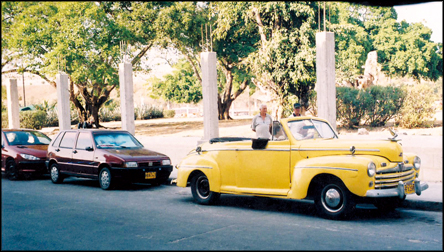Fusion of Spanish melodies and African rhythms
 Continued
from last week Continued
from last week
Once the wrapping is complete, the final touches are added. First the
wrapper leaf is worked until it is completely smooth. Then comes the
trimming. The cigar tip is finished off by wrapping the end with a last
tobacco leaf.
Once the cigar is finished, the diameter is checked with a special
gauge stamped with various standard sizes established for every kind of
cigar. The same instrument is also used to measure the pre-established
length after which the cigar is cut to this size using the cutting
machine.
The tobacco plant grows from small, round, golden seeds. Cuban
tobacco seeds are in demand throughout the world because their quality
is considered to be very good. Tobacco plants are quite delicate and
require skilful handling.
The Cuban government allows private tobacco growers to have 17 acre
plots, but the State is still the sole manufacturer and distributor of
cigars.
We were not allowed to take photos inside the factory. However, we
were permitted to photograph the lady inside the Pantages sale room.
The hundreds of young men and women are going through the described
process of manufacturing cigars.
The popular brands are Montecristo, Pantages and Cohibas and Romeo
and Juliet. We were told that the brand names were inspired by most
favourite books the cigar makers read during their break.
Transport
 |
|
American cars on Cuban
roads |
Since the energy crisis of the late 1980s when the Soviet Union and
Eastern European countries stopped supplying Cuba with the petrol it
needed, every possible means have been used to get around the Island.
Cycle pedal rickshaws were recently introduced to Cuba as another
solution to the fuel shortage. They are used for short trips in towns
and each can carry up to two people. The traditional carriage is a one
horse drawn vehicle.
Vintage cars
Because of the embargo and the shortage of petrol, the Cuban
government prohibited the sale of vehicles to private citizens. Cars
made in the 1940s and 1950s mostly American makes, could not be replaced
and owners have had to do their utmost to preserve and restore them and
keep them running which was not an easy task in the absence of spare
parts.
Cuban car mechanics have been forced to devise ingenious creative
solutions and have even been known to fit Lada engines in Chevrolets It
is quite common to see museum pieces on the streets. The Cadillacs and
1930-s Fords have been fashionable cars to own in Cuba. The Chevrolet is
the most commonly seen car in Cuba, appreciated for its durability and
space. The popular Bei Air, 1956 and 1957 collectors models of Chevrolet
is commonly used as taxis.
Reproduction of the Swan with outspread wings from Chevrolet bonnets
is sold in the market to replace the originals. In the late 50s, it was
a common sight to see Ernest Hemingway driving his brand new 1955
Chrysler New Yorker Deluxe Convertible enroute for his daily drinking
sessions with his friends.
After his death, Hemingway’s’ sleek black Chrysler New Yorker escaped
the clutches of the Cuban government and apparently passed into the
hands of Augustin Nunez Gutierrez, a Cuban Policeman, according to
writer Joann Biondi, later Nunez hid the car and hopped on a raft for
Miami. Popular legend says the car’s whereabouts are still a mystery and
that the Chrysler still awaits discovery as some incredibly fortunate
collector’s dream.
Music and dance
Anything can be used to make music in Havana at anytime, anywhere.
The most popular music is a fusion of Spanish melodies and African
rhythms which is the very essence of Cuba. Today its son, rumba and
salsa. Dance is an essential part of life with the Cuban people. This
country is moving, swaying and rocking to the rhythms.
‘Son’ is a type of country music that originated in Cuba in the 19th
century, a blend of African rhythm and Spanish melody, which then
greatly influenced Latin American music as a whole. In around 1920,
*son* began to be played in towns, in Eastern Cuba, where, along with
other genres, it produced the trova traditional, a Ballard style sung
with guitar.
The popular salsa is the dance music which maintains the rhythmic
structure of son, while adding new sounds borrowed from jazz and other
Latin American genres.
Exclusive Cuban musical instruments consist of the tres, a small
guitar, always used in son bands, with three paws of metal strings and
the ‘requinto’, another small, high pitched guitar that is used in trios
to play melodic variations. Typical Cuban percussion instruments are the
‘tumbadora’, a tan wooden or leather drum played with the hands, which
is used in all musical forms, including jazz, the bongos, two small
round drums, the claves, two wooden cylinders played by striking them
against one another, the ‘guiro’, and the gourd of a guira fruit which
is stroked with a small stick, and the marimbula a rarely used small
piano.
The Rumba of course is the African core of Cuban music, the rumba
originated in poor neighbourhoods as a voice of rebellion against
slavery and segregation. It then became a form of political expression
of an unhappy love affair. Columbia is country-style rumba, white
‘yambu’ and guaguanco are the urban varieties, with a dance rhythm that
can be sensual and dynamic or sad and stow.
Wim Wonders in his 1988 film, “Buena Vista Social Club” brought into
the limelight traditional son interpreters Ruban Garzalez and the singer
Ibrahim Ferrer. |

